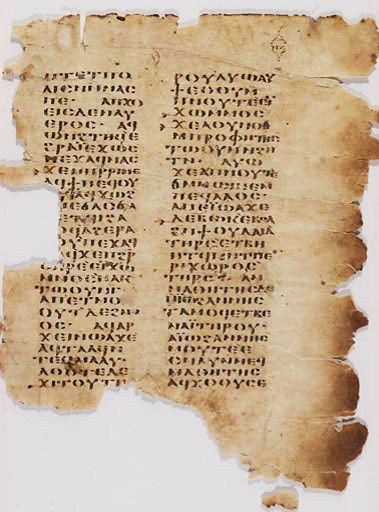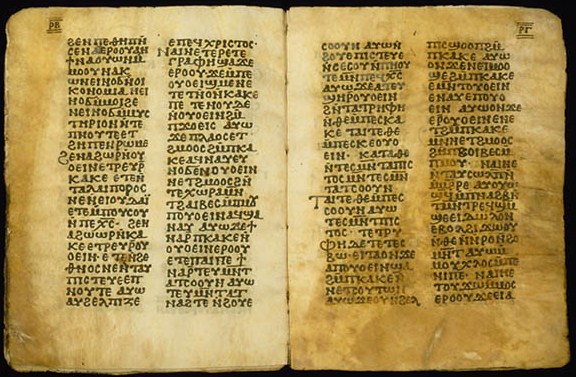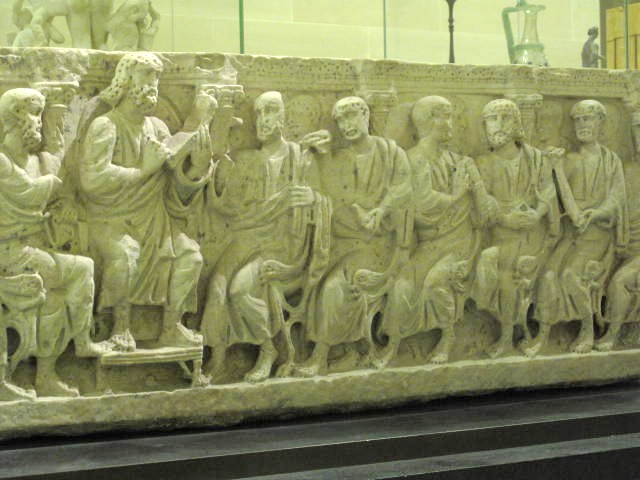The appearance of the codex, that is to say, either in rolls of book but books written sheets on both sides, is certainly the most important revolution whose book was the subject during our era. And if they were not the inventors of leaf book, however, Christians were the first to use it. With the codex, the Bible could become a book.
Booklet schoolboy Theodoros
MNE 914
Fayoum (Egypt) VII th s NS Beech wood, wax Denon Ground floor
30 living room 2 This codex copy,
very rare by its condition,
belongs to a man named Theodore,
after the name engraved
on the cover.
Written in Greek characters, the book consists mainly of arithmetic exercises. The order of the tablets is discoverable through the notches in the edge of the tablets that follow. The order of the tablets is discoverable through the notches in the edge of the tablets that follow. The writing tablets to be commonly used in the time of Jesus Christ. Speaking of Zechariah, father of John the Baptist, Luke the Evangelist reports that
With the codex, the Bible could become a book
he "asked for a tablet
and wrote: 'John is his name' "
(Luke 1:63). This was probably
a wooden board covered
wax, such as that described here.
Tablet schoolboy Papnoution
MND 552, fourth century AD
Denon Ground floor room 30 2 lives
The search for a carrier has continued to be a problem. The men first tried to use natural substances, especially wood. The Chinese character that evokes the book seems to have represented initially bamboo slips and the Latin word liber evokes the notion of wood or bark. But wood hardly takes the impression of the signs.
Hence we took the habit to cover the wooden tablets with a layer of wax on which was written with a stylus. However its essentially perishable nature, writing on this support only served to note the interim. AA163
Schoolboy shelf: Kemit AF 497
Wood stuccoed 12th-13th Dynasty,
1963 - 1650 av.n.è Sully Ground floor room 6 showcase 4
First sentence of a textbook studied and copied by countless generations
of aspiring scribes: Kemit ("sum"),
a collection of precious epistolary
formulas. Malformed signs and smearing
is observed here are the work
of a student to whom much remains
to be done.
The pages of the book begins very early prehistory to the Middle East. By the second millennium BC. JC, Egyptian scribes wrote with ink on tablets of wood, sometimes coated with plaster. Babylonian scribes inscribed in cuneiform their signs on tablets covered with wax. The Hittites in Anatolia as well. This use has intensified during the first millennium; They are found on sculptures in Assyria. When the Greeks borrowed from the Phoenician alphabetic writing around 900 BC, the tablets have become commonly used in the administration. This was not the case of literary works continued to be written on rolls.
Bible derives from the Greek word biblia or 'little books'.
It comes itself from biblos, which designates the inner part of
the papyrus stem. The Phoenician port of Gebal, from which papyrus
was imported from Egypt came to be called Byblos by the Greeks.
The people of this city are Bibliens. - Ezekiel 27: 9 LXX
In ancient times, a "book" can be a clay tablet, stone, wood covered with wax, metal, ivory, or even a group of potsherds (ostraca). The handwritten roller assemblies consisted of sheets of papyrus, parchment, vellum or linen paper. Finally the book became a collection of leaves attached with string and stitched to form a bound volume.
Bible comes from the Greek word biblia or 'little books'
The Hebrew word Sefer (book, letter, writing) is related to the verb Saphar (count) and Sopher name (scribe, copyist). When appointing official documents, Sepher can be translated as 'written document' and 'act'. (Is 9:25; Jer 3: 8). Biblos is the Greek term for 'book'; the diminutive biblion (literally 'little book') is given by the book, act and roll. The word "Bible" comes from the Greek words.
The convent
Sainte - Catherine
inv 3689
Adrien DAUZATS
Sully 2nd Floor Room 71 This panting
remember a trip
made by artist
in 1830.
The monastery
has no door:
there access hoisted
in a basket
by high skylight.
Is in
this monastery
nestled at the foot
Jebel Musa,
identified
Mount Sinai
that was discovered
in the fourth century
a biblical manuscript
known today
under the name of
Codex Sinaiticus.
This is one
older complete copies
known of the
Greek Scriptures.
The Romans often used wooden tablets coated with wax to the writings of a temporary nature. Thereafter, these tablets were replaced by sheets of leather or parchment. The Latin word membranae (skins) designated this kind of parchment notes booklet. In 2 Timothy 4:13, the apostle Paul asked Timothy to bring "the scrolls, especially the parchments." In this text, Paul uses the Greek equivalent of the word [membranes]. He did not specify the content of the documents he claimed; however, it is quite possible that he asked for portions of the Hebrew Scriptures in order to study them during his imprisonment in Rome. AA164
When you come,
bring me the coat
I left at Troas
with Carpus and books
especially the parchments. 2 Timothée 4:13,
Segond 21
The scrolls (or parchments) were usually made
with skin of sheep, goat or calf. In the third and fourth centuries CE, appeared a distinction between Product quality levels, coarse skin keeping the parchment name (Latin pergamena, named after the city of Pergamum which was invented or popularized this method
of treatment skins) and finer, made with
skin delicate veal or kid, being called vellum.
This material was widely used for important books until the invention of printing. Important Bible manuscripts such as the Sinaiticus and Vaticanus 1209 (IV) and the Alexandrian manuscripts of the fifth century were copied on vellum. AA167
The best known example of roll
leather is one of the
rollers Dead Sea, written at the end
2 nd millennium av.n.è.
This material was used extensively
for important books,
until the invention of printing.
Important Bible manuscripts
such as
Sinaiticus and
Vaticanus 1209 (IV century)
and the Alexandrian manuscripts
the fifth century, were copied
on vellum.
AA168
Parchment inscribed in Coptic
E 9970
Gospel Luke, 7, 12b-22b.
Uncial writing biblical type. Sully room 6 sc 3.1
Parchment Codex
E 10612 XIe siècle après J.-C. ?
The Israelites used the book as roll up to the time of the Christian congregation. The documents preserved in the former national archives of Israel and Judah, and the inspired writings of the prophets of YHWH, though sometimes called books, actually arose in the form of rolls. (1 Kings 11:41; Jer 36: 4). In every synagogue, which appeared after the Babylonian exile, we kept the Holy Scriptures rollers, we publicly read every Sabbath (Acts 15:21). Jesus read an excerpt from one of these rollers, probably the same kind as the Isaiah Scroll of the Dead Sea. - Luke 4: 15-20
The appearance of the codex,
that is to say, not the book but in
rolls in books written sheets both sides is for sure the most important revolution that the book was the subject
during our era.
In the second century struggle pitted
Codex supporters with those of the roll.
If they were not the inventors of the book
sheets, Christians have been
however, the first to use it.
The first evidence comes from those encountered six epigrams of Martial (40/130 n.è). And HJ Martin AA165, "while the traditional public will remain faithful to the elegant volumen, Christians prefer to set their sacred texts and writings of their doctors in the new form, which facilitated their consultation. "In the early Church there were men well aware of the role that editing plays in the Greco-Roman world. In their zeal to spread the Christian message, they adopted all publishing techniques.
Thus they began to be used on a large scale in the book leaves. They did not work only with their time, they were ahead of their time. AA169 AA175
Sarcophagus: educational scene
MA 2958
Late fourth century AD
White marble.
On the main face, Christ throne,
seated in the center, feet on
a low stool. He holds in his
hands a book and teaches
the Apostles who are also sitting
and take rolls or books.
Denon Ground floor room 30.
It seems that Christians have used books mainly in rolls at least until the end of the first century of n. è. In the second century struggle pitted the Codex supporters to those of the roll. If they were not the inventors of leaf book, however, Christians have been the first to use it. It is the publication of the Bible that has stimulated the development of leaf book, and it is the publication of the Bible that will boost the invention of printing. With the codex, the Bible could become a book.
E. Goodspeed, Christianity Goes to Press, 1940 E. Lalou, les tablettes à écrire de l’antiquité à l’époque moderne, Paris, oct 1990, Bibliographia. Henri-Jean Martin, Histoire et pouvoirs de l’écrit, Albin Michel, 1996, p 70-71 Alan Millard, Reading and writing in the time of Jesus, Sheeffield Academic Press, 2001, p 26-41 William M. Schniedewind, Comment la Bible est devenue un livre, Bayard, 2006, p 12
C.H Roberts, the Birth of the Codex, London, Oxford University Press, 2004 Vigouroux, Dictionnaire de la Bible, Letouzey et Ané, Paris, 1912, tome IV, p 302, Livre
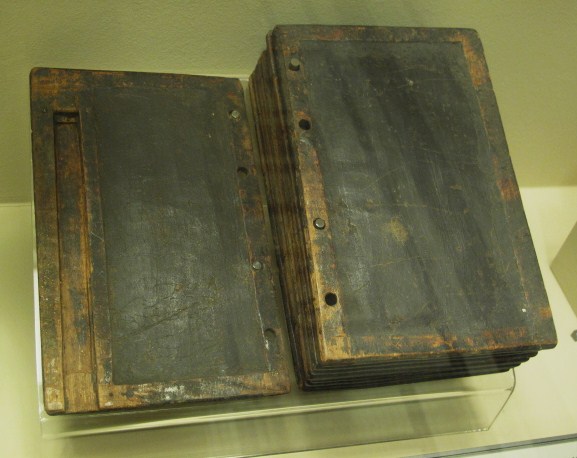
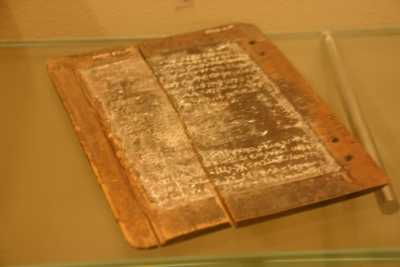
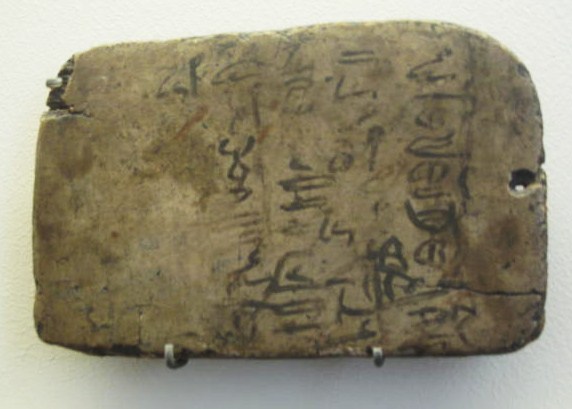
.JPG)
